Disclosure: Some posts contain affiliate links, which earn us a commission if you make a purchase through them. Positive Fishing © participates in various affiliate networks including the Amazon Services LLC Associates Program.
There are quite a few different types of carp that you might find on the end of your line while fishing in the UK, and it can be quite hard to differentiate between them.
In this article, we will cover the main species of carp you will likely catch in the UK and all the details you need to know to identify them. By the end, you should know what the types of carp are, how big they grow, and be able to spot them instantly.
How Many Carp Types Are There?
There are over 2,000 species of carp (Cyprinidae) across the world. There are 12 main carp species across Europe and North America; nine of these types are found in the UK, and three are found in North America but not in the UK.
You can learn more about all the aspects of fishing for carp in the United States, which covers specifically the type of species, best baits, and where to fish for them.
Most carp belong to the Cyprinidae family and share some common traits. For example, common carp and mirror carp are the most common species of carp you are likely to experience, but their relatives, ghost, linear, crucian, and leather carp, are also likely catches.
Then you have koi carp, grass carp, and silver carp, which are not relatives of the abovementioned carp.
The Types Of Carp
Mirror Carp
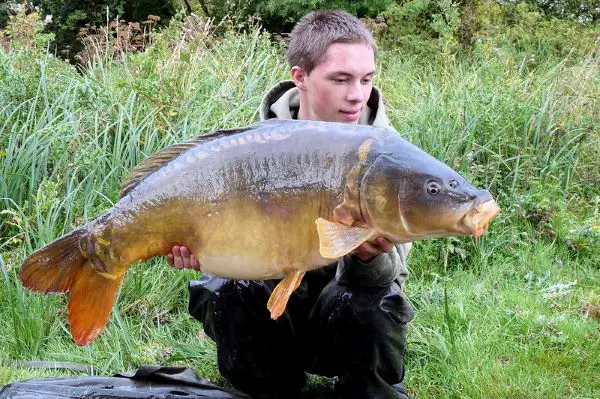
The mirror carp is also a member of the Cyprinidae family and is directly related to the common carp. The mirror carp was created by humans changing the breeding conditions when carp were farmed by monks in Europe almost 1000 years ago.
The monks cooked the common carp, but since they had so many scales, cleaning and serving up for dinner was difficult and time-consuming. So they began altering the common carp to reduce its number of scales, so the mirror carp was born.
You will find mirror carp in still-water lakes and ponds but not rivers as they are not adapted to the moving water you find in rivers.
What Does A Mirror Carp Look Like?
Mirror carp get their name from the patches of scales or individual scales they have on their body. The scales can be scattered, of different sizes, and even found on any random body part.
This makes each mirror carp unique as each has a specific scale pattern that allows anyone to identify individual fish. At carp fishing lakes, where anglers fish the same lake often, they will name a specific fish based on its scale patterns.
Mirror carp have a deep round shape and can get very wide and fat. Even though mirror carp can get rather rotund, they can also be slim and beautiful. They are brown in colour, and when you hook the big ones, they fight extremely hard.
How Big Does A Mirror Carp Get?
Being quite a fatty species of carp with a round body, mirror carp are actually, on average, larger than most other carp of equal length, especially common carp.
The average weight of a mirror carp is between 15 and 25 lbs, but some true monsters exist beyond the 40 lbs mark. A 50 lb mirror carp is a massive specimen, and the record mirror carp in the UK is a whopping 71 lbs!
The world record mirror carp is an astonishing 112 lbs and 14 ounces, and it was actually caught in Hungary at a fishery called Euro Aqua.
Common Carp
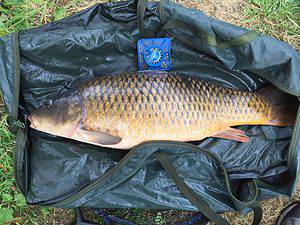
when I was method feeder fishing
The common carp is native to Asia, but now you can find them worldwide. They were farmed in Asia for centuries and were finally farmed in Europe in the 1100s but didn’t make it to the UK until the 1500s and the United States until the 1700s.
Common carp are the most widespread of all the carp found in the UK.
What Does A Common Carp Look Like?
Unlike mirror carp, common carp are covered in stunningly symmetrical scales, giving them a kind of golden sheen. This means they are impossible to identify as individuals because they have no unique features.
Common carp usually have a long, slender torpedo shape, and this is because they were originally river fish that used to have to fight the current and stay lean to do so. But, lake or pond-bred common carp can be round and wide-bodied like mirror carp.
Common carp are bronze in colour and can sometimes have a red or orange tail fin. They are pretty-looking carp, especially when long and torpedo-shaped. They also fight very hard as they are used to living in rivers, which is why anglers love to catch them.
How Big Does A Common Carp Get?
Common carp aren’t quite as big as mirror carp when it comes to average sizes, and a good-sized common carp is considered to be over 30 lbs, while an average-sized fish is in the 10 to 20 lbs range.
That’s not to say that you can catch a monster common carp; the world record is a 101 lbs 6oz fish known as “the big girl” caught in Lake Serene in France. Carp fishing in France is one of the favourite locations for anglers searching for huge specimen fish, and most lakes have a two years waiting list!
The current UK record stands at around 64 lbs, so some giant common carp are out there.
Grass Carp

Grass carp are very distant relatives to the common carp, and while still a member of the Cyprinidae family, they are completely separate fish altogether.
The grass carp were also farmed in Asia to feed the population, and again, they were introduced to Europe and the US for one purpose: weed control, since they eat a lot of weeds, hence the name.
Grass carp are incredibly strong carp, and they pull harder than all the others, in my opinion, although they are a bit tricky to catch.
What Does A Grass Carp Look Like?
Grass carp look a bit like common carp thanks to their similar scale patterns, but their long torpedo shape makes them look quite different, and they don’t have the barbles that most carp have near their mouth.
Thanks to their scales, they have a golden colour, but their head and tail are much darker. These carp have a big tail, and combined with their torpedo shape, this makes them a real handful during the fight.
How Big Does A Grass Carp Get?
Grass carp, on average, is a similar size to mirror carp and common carp, usually hitting the 15 to 30 lb mark. If you land a grass carp over 40 lbs, then you have caught a giant, and something near 50 lbs is a catch of a lifetime.
Grass carp in the UK don’t grow to huge sizes, with the UK record sitting at 53 lbs, while the world record is a crazy 87 lbs caught in Bulgaria.
Koi Carp
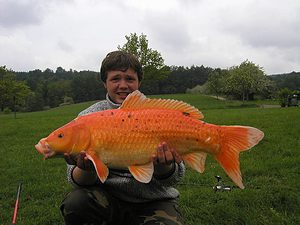
fishing for common carp!
You probably associate koi carp with Japan because the word Koi is Japanese, meaning “brocaded carp”. Koi carp were first bred in Japan in the 1800s and used as decorative fish in their stunning Japanese gardens due to their beautiful colours.
The idea of having decorative koi carp at home quickly caught on around the globe, and a large koi carp is worth a lot of money. People even steal them from ponds to sell them for a big profit.
Koi carp have also found their way into a few carp fisheries, usually irresponsibly. They are relatively rare to find across most lakes in the UK.
What Does A Koi Carp Look Like?
Koi carp are stunningly beautiful and can come in various colours and variants. This makes them quite exotic and surprising when you hook one and see the stunning colours.
You can find mirror koi carp and common koi carp, as they are closely related, and there is a chance that you may find a mirror koi at the end of your line or possibly a ghost koi, too. They have their own colours, but the scale patterns are similar, and they have barbels like common and mirror carp.
How Big Does A Koi Carp Get?
Koi carp are, on average, a bit smaller than most other types of carp, and a 10-20 lb fish will be considered average, and anything over 25 lb is a solid fish.
They don’t tend to grow very big in lakes, but in a pond, they get much bigger and can push over 80 lbs in some cases. The record koi carp caught in the UK was around 47 lbs.
Linear Carp

A linear carp is another relative or variation of the mirror carp, and it can be easily confused with mirror carp if you don’t know how to identify them.
What Does A Linear Carp Look Like?
Linear carp is one of the most beautiful carp out there, and this is often the opinion of most carp anglers too.
They get their name from having a line of stunning scales flowing across their lateral line, unlike any other carp. This line of scales is pretty much the only scales you will find on a linear carp.
But, being a relative of a mirror carp, it can also have random patches of scales on other parts of the body. They can also be called zip carp or line carp, as the scales look like zip or are straight.
Its body shape is very similar to a mirror carp with a wide round body, but it doesn’t hold as much fat as a mirror carp.
How Big Does A Linear Carp Get?
Linear carp do not grow as big as their mirror carp relatives, and a fish over the 30 lb mark would be considered quite a huge fish.
On average, you should expect to catch a linear carol of around 12 to 25 lbs, but they are not as commonly found in fisheries as mirror carp or common carp. Linear carp are quite rare and can only be found in specific lakes around the UK.
Leather Carp
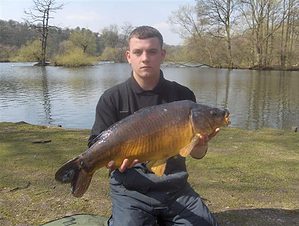
Leather carp are a result of genome sequencing changes used in Asia, particularly South Korea, to farm these carp for food purposes. Therefore, they are very different from common carp and mirror carp.
What Does A Leather Carp Look Like?
Leather carp are sometimes referred to as nude carp as they have none or few scales on their body and look a bit like leather, hence the name leather carp. You might find one or two scales next to their tail fin and close to the dorsal, but that is it.
Having almost no scales whatsoever means that identifying a leather carp is incredibly easy as it needs to be since they have a very similar body shape to that of a mirror carp. But, the body has a dark browny grey colour, which should also help identify them a little easier.
How Big Does A Leather Carp Get?
Leather carp don’t grow as big as mirrors and have an average size of 10-20 lbs, and a leather carp over 30 lbs would be considered a serious fish.
The UK record for a leather carp is an amazing 54 lbs and 8 oz, and it’s thought that this fish was over 50 years old.
Ghost Carp
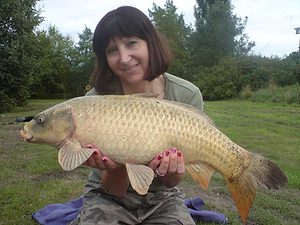
and the pale, whitish body
Ghost carp result from a hybrid between a common carp and an Ogan koi carp. Ghost carp are typically named “ghosties” by many anglers. They are also sometimes referred to as ghost koi.
What Does A Ghost Carp Look Like?
Ghost carp are normally silver or white in colour, which explains the reference to a ghost. Another distinctive difference from other carp is they have metallic and dark ring markings on their head (around the eyes) and bodies. These rings tend to create a ghost-like look, particularly when they are swimming underwater.
In most cases, they have a whitish look about their body, making it easy to distinguish them from other carp.
How Big Does A Ghost Carp Get?
Ghost carp grow as big as mirrors and commons and have an average size of 10-20 lbs, and a ghostie over 30 lbs would be considered a specimen.
Jack Rose caught the UK record for a ghost carp at a staggering 63lb 2oz! This ghost carp named “milestone” was caught at Embryo Angling habitats‘ Broom big lake, a 45-acre pit in Bedfordshire. This carp syndicate lake happens to be less than 10 miles from my home in Bedford.
Crucian Carp

Crucian carp is a fully scaled small to medium-sized carp known to be one of the tougher carp to catch. They are also very hardy fish that can survive extreme cold or hot weather better than most fish species.
Crucians are a native species of the UK and are native to British waters, meaning they have not been introduced like the other carp species. They are fondly referred to as crucians or as “bars of gold” and are beautiful fish.
What Does A Crucian Carp Look Like?
Crucian carp look similar to the common carp as far as their scales are concerned. However, it has no barbels around its mouth and a deeper girth than most other carp.
The body colour of a crucian naturally alters based on the type of water it lives in; usually, they are a deep golden bronze or, in some cases, black.
How Big Does A Crucian Carp Get?
Crucians are one of the smallest carp with an average size of 1 lb to 2 lbs, and any of over 3 lbs would be considered a large specimen.
The UK record for a crucian carp was caught at 4lb 12oz in 2021. The fish was caught in Johnsons Lake, Surrey.
Full-Scaled Mirror Carp
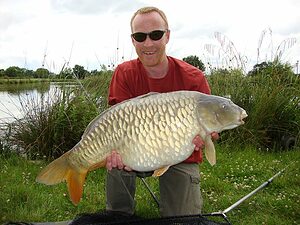
A full-scaled mirror carp is a variant of the mirror carp we mentioned earlier in this article, except it will be covered or almost covered by scales instead of having patches of scales. This makes them a little easier to be confused with common carp, but the larger scales should give them away quite easily.
Catching a full-scaled mirror carp is awesome as they are stunning, beautiful carp when they are covered in those big shiny mirror scales.
In terms of body shape, they are the same as mirror carp with a round body shape.
How Big Does A Full-Scaled Mirror Carp Get?
Full-scaled mirror carp don’t grow anywhere near as big as mirror carp. An average size full-scaled mirror carp will be in the 10-20 lbs range, while a fish over 20 lbs would be considered a big fish.
There is no official record since fully scaled mirror carp are not judged as a different species.
F1 Carp
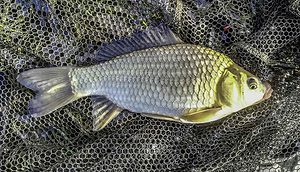
F1 carp are last on my list; I do not consider them a species like the others. An F1 is a hybrid between a common and a crucian carp.
These fish were solely farmed 30 years ago for commercial fisheries in the UK, with match anglers being the main reason for developing them. Like the crucian, F1’s grow fast and are very hardy and tough-fighting fish pound for pound.
Fishing in the margins around the lake is one of the best methods to catch F1s.
What Does An F1 Carp Look Like?
Many anglers struggle to identify an F1 carp because they look very close to a common carp.
One major difference is the barbels around its upper mouth. F1 carp only have one pair of small barbels compared to common carp’s two pairs of barbels.
How Big Does A F1 Carp Get?
F1s are much the same size as crucians, with an average size of 2 lb to 3 lbs, and any over 4 lbs would be considered a good size F1.
There are no official F1 records kept, which is why I included F1 at the end of this article. The largest claim to have been caught is 13lbs 10oz at the Square Lake in the Warren Fishery, Essex, 2021.
Carping Out
Thanks very much for reading my article. I hope you enjoyed it and now know about most types of carp you might come into contact with and how to identify them.
Please share the article with any of your carp fishing friends, and go and check out some of our many other articles on catching carp, such as the best carp hookbaits and carp fishing on the fly.
- 5 Best Fishing Bags For Getting Your Gear Organized - January 13, 2025
- 4 Essential Surf Fishing Rigs - January 11, 2025
- How To Know The Sex Of A Fish You Have Caught? - December 9, 2024

